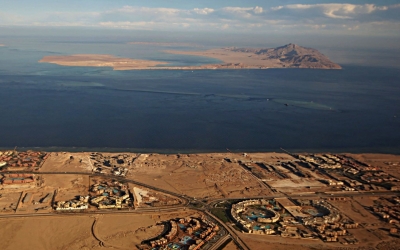Saudi Arabia officially adds Red Sea islands of Tiran and Sanafir to its map

Saudi Arabia has officially added the Red Sea islands of Tiran and Sanafir to its map, years after Egypt ceded its sovereignty over them, the Saudi Press Agency reported on Monday.
Saudi Arabia's General Authority for Survey and Geospatial Information (GASGI) announced a new, updated map of the kingdom’s borders, which included the two islands, Tiran and the newly renamed Sanafer, which have long been a point of contention between Egypt and Saudi Arabia, according to the state-run agency.
The GASGI called on government authorities to publish only the new official map of the kingdom on websites, in the media, books, or brochures, according to the agency.
“GASGI emphasises the importance of government agencies that represent the Kingdom in international organisations, conferences, and forums related to geospatial data,” the Saudi Press Agency reported.
“They are urged to furnish event organisers with up-to-date official maps of the Kingdom. This ensures that international land and sea borders, as well as islands, are accurately depicted.”
New MEE newsletter: Jerusalem Dispatch
Sign up to get the latest insights and analysis on Israel-Palestine, alongside Turkey Unpacked and other MEE newsletters
The transfer comes seven years after Egyptian President Abdel Fattah el-Sisi signed an order in 2016 ceding the islands officially to Saudi Arabia.
Saudi King Salman bin Abdulaziz Al Saud visited Cairo in April the same year, announcing a multi-billion-dollar package of investments for Egypt, in what Saudi Arabia’s Okaz newspaper described as a "festival of happiness in Egypt”.
The deal between the two countries hasn't been without controversy.
Following the Egyptian parliament's approval of the deal, widespread protests broke out across the country, with demonstrators chanting “Egyptian! Egyptian!” in reference to the islands' sovereignty.

Egypt and Saudi Arabia have laid claim to the territories since the mid-20th century.
Tiran, and its smaller eastern neighbour Sanafir, are located at the mouth of the Gulf of Aqaba, which holds harbours belonging to both Saudi Arabia and Egypt.
The entrance to the Gulf of Aqaba is also the location of Israel's Eilat harbour and Jordan's Aqaba.
Administered for most of the time by Egypt, the islands were occupied by Israel in 1967, before being handed back to Egypt in 1982 when the two sides signed the Camp David peace accords.
The two islands have been the base of a small, multinational peacekeeping force since 1979, following a peace deal between Egypt and Israel. The 61 square kilometre Tiran also hosts an airport, used by the troops.
For months, the US was said to be brokering a deal to transfer Tiran and Sanafir from Egypt to Saudi Arabia.
In July 2022, US President Joe Biden said that international peacekeepers, including US troops, would leave Tiran by the end of the year.
That same month, Israeli officials told Axios they had given the green light to approve the transfer of the strategic islands to Saudi Arabia, clearing another hurdle that could pave the way for a formalisation of ties between Riyadh and Tel Aviv.
The two islands were supposed to be transferred from Egypt to Saudi Arabia in 2018. But the deal required Israel's permission for any change in the status of international forces on the territory, because of the 1979 Israel-Egypt peace treaty which required international observers to be stationed on the islands, according to Axios.
Middle East Eye delivers independent and unrivalled coverage and analysis of the Middle East, North Africa and beyond. To learn more about republishing this content and the associated fees, please fill out this form. More about MEE can be found here.




